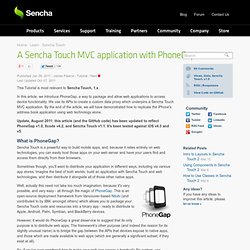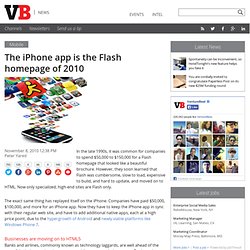

Tutorial:A Sencha Touch MVC application with PhoneGap - Sencha - Learn. This Tutorial is most relevant to Sencha Touch, 1.x.

In this article, we introduce PhoneGap, a way to package and allow web applications to access device functionality. We use its APIs to create a custom data proxy which underpins a Sencha Touch MVC application. By the end of the article, we will have demonstrated how to replicate the iPhone's address book application using web technology alone. Update, August 2011: this article (and the GitHub code) has been updated to reflect PhoneGap v1.0, Xcode v4.2, and Sencha Touch v1.1. It's been tested against iOS v4.3 and v5. What is PhoneGap? Sencha Touch is a powerful way to build mobile apps, and, because it relies entirely on web technologies, you can easily host those apps on your web server and have your users find and access them directly from their browsers.
Sometimes though, you'll want to distribute your application in different ways, including via various app stores. Installing PhoneGap Not good. Add to home screen message for iphone and ipad. Support Development Add To Homescreen is a free, open source javascript software.

It is released under the MIT License which basically grants you complete freedom in usage for open source and commercial applications. That being said the only way for me to subtract hours from my day work and keep implementing this script is through donations. If you find this widget useful and wish to support future development, please consider a donation. Overview The script opens an always-on-top message inviting the user to add the application to the home screen. ATH by default looks something like this But appearance is customizable with plain old CSS. The script is compatible with iOS 6+ and Chrome 31+. Languages The message changed in v3 so unfortunately all the languages supported in v2 are not available anymore. Basic Usage v3 API changed drastically (sorry about that) and it’s not a drop in replacement for v2.
<head><title>Add To Home</title> ... That’s all you need. Options Detect the homescreen. Make custom mobile apps, web widgets, and rich media ads. The iPhone app is the Flash homepage of 2010. In the late 1990s, it was common for companies to spend $50,000 to $150,000 for a Flash homepage that looked like a beautiful brochure.

However, they soon learned that Flash was cumbersome, slow to load, expensive to build, and hard to update, and moved on to HTML. Now only specialized, high-end sites are Flash only. The exact same thing has replayed itself on the iPhone. Companies have paid $50,000, $100,000, and more for an iPhone app. Now they have to keep the iPhone app in sync with their regular web site, and have to add additional native apps, each at a high price point, due to the hypergrowth of Android and newly viable platforms like Windows Phone 7. Businesses are moving on to HTML5 Banks and airlines, commonly known as technology laggards, are well ahead of the rest of the industry when it comes to mobile access to their systems.
The native vs. The digerati in Silicon Valley have been arguing ad infinitum about the merits of native vs.